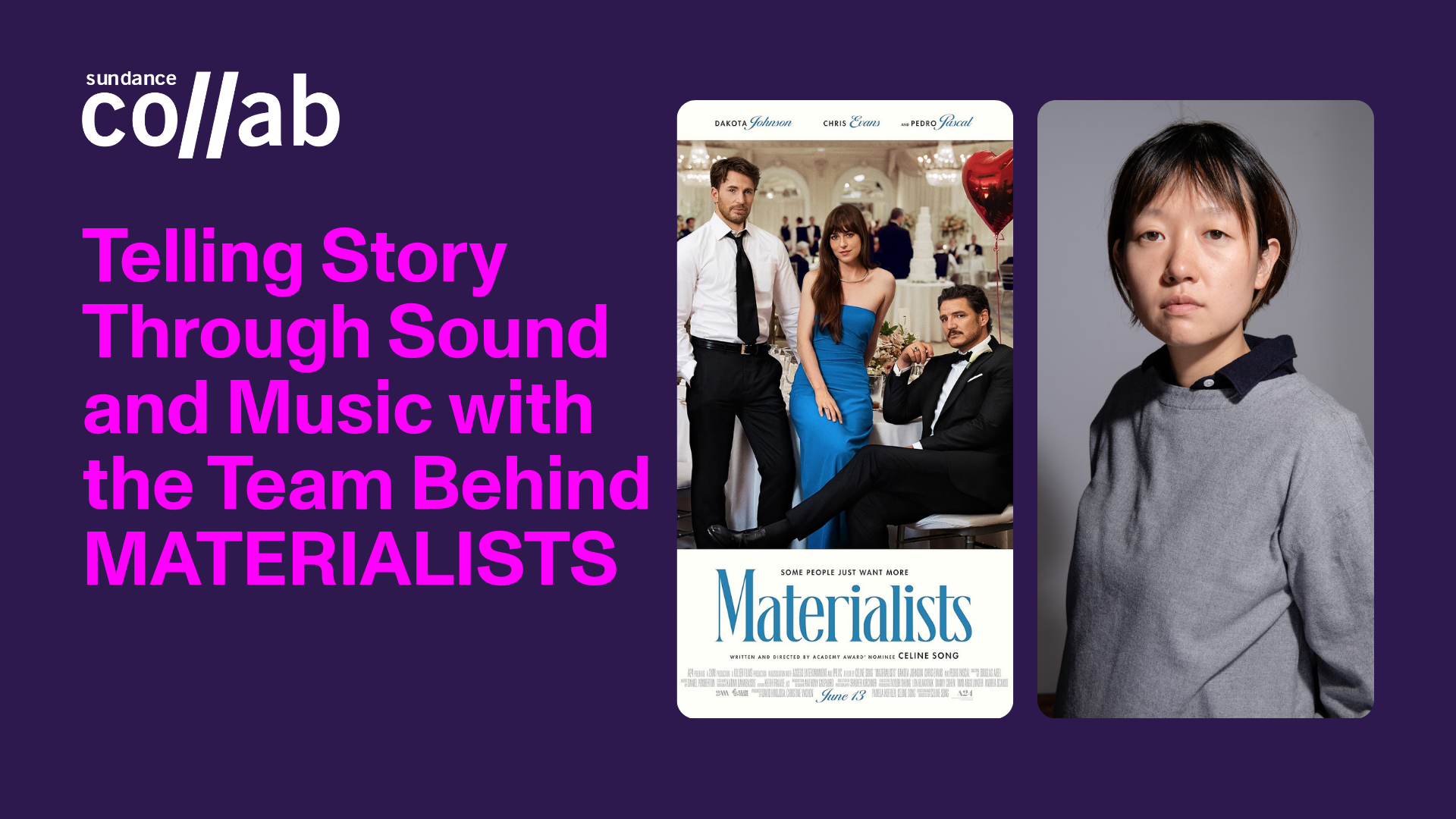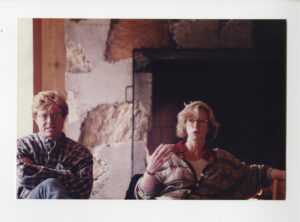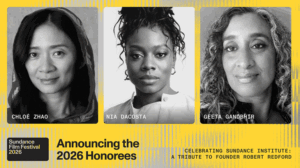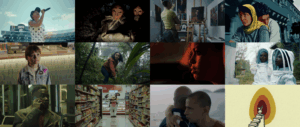By Jessica Herndon
Sound and music aren’t embellishments in film — they’re storytelling tools that can shape emotional beats and signature settings. Think of the terror evoked by John Williams’ Jaws main title “The Shark Theme” or the sweeping heartache we feel when hearing James Horner’s Titanic main title “Rose.” The power of sound in film is what the crew behind Materialists recently explored in the Sundance Collab conversation, Telling Story Through Sound and Music with the Team Behind Materialists | Presented by the Dolby Creator Lab. The discussion offered a look into how director Celine Song, composer Daniel Pemberton, supervising sound editor Daniel Timmons, and re-recording mixer Josh Berger crafted the film’s audioscape.
The collaborative process between these four artists is a masterclass in creating sound and music that elevates storytelling. Materialists exemplifies this sonic artistry through its exploration of modern relationships. The film follows Lucy (Dakota Johnson) as an ambitious New York matchmaker whose carefully constructed philosophy on what makes couples compatible is challenged as she becomes torn between a wealthy stranger, Harry (Pedro Pascal), and her imperfect ex, John (Chris Evans).
From the exciting energy of New York’s dating scene to the intimate moments of vulnerability it can produce, every audio choice in Materialists supports Song’s story of how we navigate love in a material world. Behind Materialists’ sophisticated audio landscape stands a powerful team of Sundance Film Festival alumni, each bringing their unique expertise to Song’s vision.
The Oscar-nominated writer-director, whose breakout film Past Lives premiered at the 2023 Sundance Film Festival, collaborated with Pemberton, whose Fest credits include Enemy of the People (2010) and In Fear (2013), and who has since crafted memorable scores for Spider-Man: Into the Spider-Verse and Ocean’s Eight. Joining them are re-recording mixer Josh Berger, who worked on the Festival premiere So Good to See You (2016) and has lent his talents to films like King Richard and Presence, and supervising sound editor Daniel Timmons, a Fest veteran from Midnight Traveler (2019) who previously collaborated with Song on Past Lives and worked on Jesse Eisenberg’s A Real Pain.
During the conversation, the filmmakers give details on how they used dialogue, effects, and score to elevate the emotions of this modern romance. From the “ambient electronic piece” Pemberton discusses creating, to the faint sound of wind that ruffled Lucy’s hair during an intimate moment with John, below the Materialists crew offers insight into the sound and feel of the film.
On how early Celine Song starts thinking about music in her films.
Celine Song: In this movie, I think that there were already needle drops written into the script. But as soon as the script is done, I’m thinking about what kind of sound and what kind of composition. And then, of course, because of how much I think about sound design as part of storytelling, I already kind of have an idea what I’m writing the script for, how the soundscape will come together. Sometimes it will be something as simple as I know that this particular sound is coming or is going to be what leads to the next cut. It happens as I’m writing it.
Daniel Pemberton on his approach to composing the music for Materialists.
Daniel Pemberton: The thing that really stuck out to me was this first scene [in which we see a pair of early human hunter gatherers in love] because the first scene is so magical and so unexpected that I really was like, I want to try and write what I called caveman music — which is probably not the best term for it — and try and transport that into the world of modern dating. I started writing with sticks and stones, and it was kind of interesting. But it had no real emotional connection. So, I started writing other bits and putting things together with flutes. One of the main [pieces] became Harry and Lucy’s dating music — this ambient electronic piece.
Early on [I was] trying to find the limit. I find limitations really interesting and I like restricting to a certain number of sounds or a certain type of language. This flute sound sounded a bit like a bird call. That was what I really leaned into. I like the mixture of this sort of weird bird call and these wooden sticks that I was playing with, then mixing that with something more contemporary — the electronic elements.
On when Song chose to lean on sound design instead of score in the film.
Song: Sometimes, when there are tough moments in the movie or there are moments where it’s meant to be difficult, the problem with any music, no matter how dark it is, is that it is going to provide pleasure. Of course, I’m asking Daniel [Pemberton] to [create music that is] really complicated, really emotional, really dark. But the problem that I would run into is the audience will still have a little too much fun just because there’s music in it. So, to make the audience really confront something or to really feel something emotional, they need to be left in silence.
Pemberton: Using less music makes music more powerful when it comes in. Space is very important for setting the tempo of a film.
On filming in New York and the art of mastering the subtle sounds in the film.
Daniel Timmons: Shooting in New York is always hard because of all the obstacles of shooting on the street. There’s always loud cars and things going by. The beauty of this film is in its silence or in its quieter moments. I found that we spent a lot of time in these quiet moments adding small subtleties. In the trailer there’s the scene where [Lucy and John] are out by the loading dock and [there is] just the subtle wind in her hair. We added all these smaller textures to help the viewer lean in just enough so that when we get intimate with the characters, the viewer is right there with them.
Song: Something that we talk about a lot is being imperceptible as sound design. As in, I don’t want anybody to know that we added that little car driving by. The goal is you want it to sound like that’s just what you captured on set when you were rolling the camera. That’s one of my favorite sound design elements in this movie.
Song on her relationship with the sound team while shooting.
Song: I want our sound team on set to be as close to the creative as possible because we’re going to do amazing things with it. Because sound is one of those departments — it’s not something you can see on a monitor — they’re often seen as a source of annoyance. For camera and lighting, everybody feels very comfortable spending an hour lighting it and setting up the camera. But when it comes to sound, the sound is like, “Can I have 20 seconds?” To me, it’s about developing a culture where sound is treated with equal amounts of respect as a picture. That’s something that has to come from the director. When the director is not rolling their eyes, nobody in the crew will either. And then of course, we’re going to reap the benefits of it when sitting in the final mix.
On balancing the bustling sounds of New York with the dialogue and action in a scene.
Timmons: The one thing that I did want to add [in a scene where Lucy and her client argue on the street] was the sound of the construction site right behind them, and, the chipping away of the facade, if you will, which is what happens. That was the most fun — to find where that could support the scene.
Josh Berger: We’re not just putting things in there, just to put it in there to fill out the space. We’re trying to add things that will help tell the story at that right time through sound. What they’re saying is so emotional. And at that point in the film, we know we’re in New York. So, we want to add things that are going to add tension, release tension and where to place them around certain lines of dialog, to help punctuate things. All of that stuff was intentional. It’s very impactful where certain things are placed, even if it is a car horn. Where does it start? Where does it stop? How does it impact the next line of dialog or where they are in their conversation? A lot of thought goes into that stuff.











